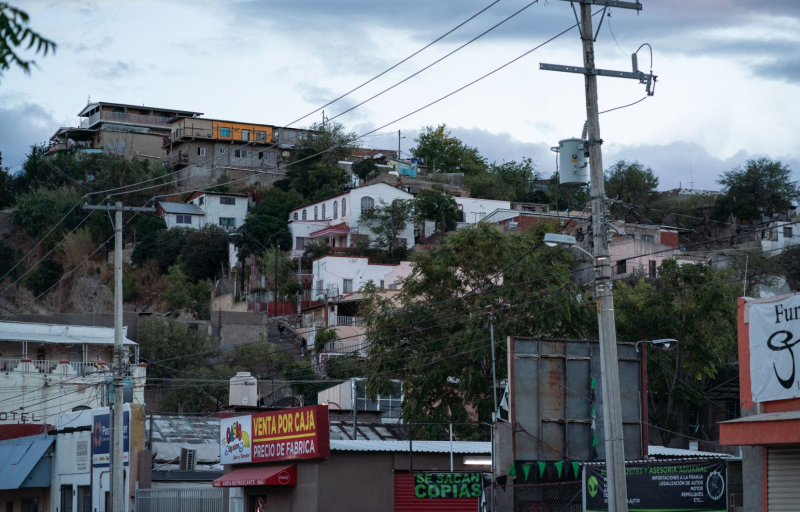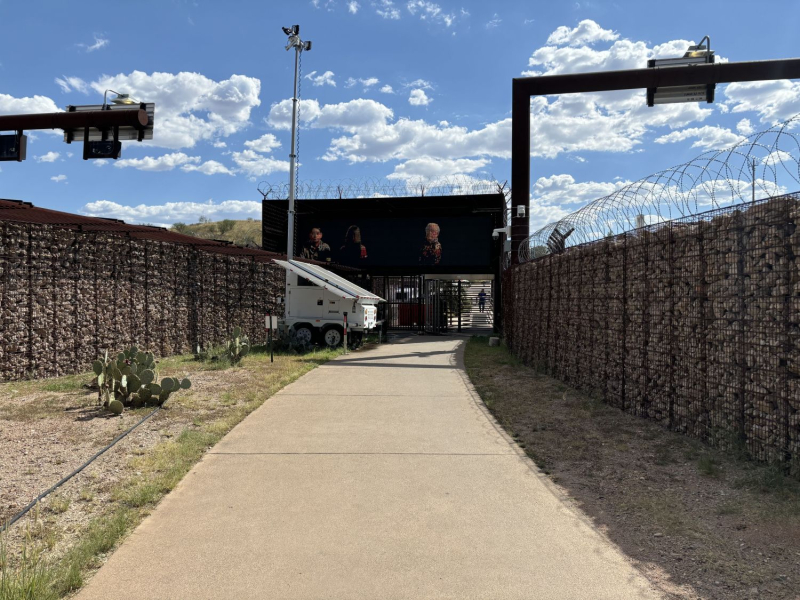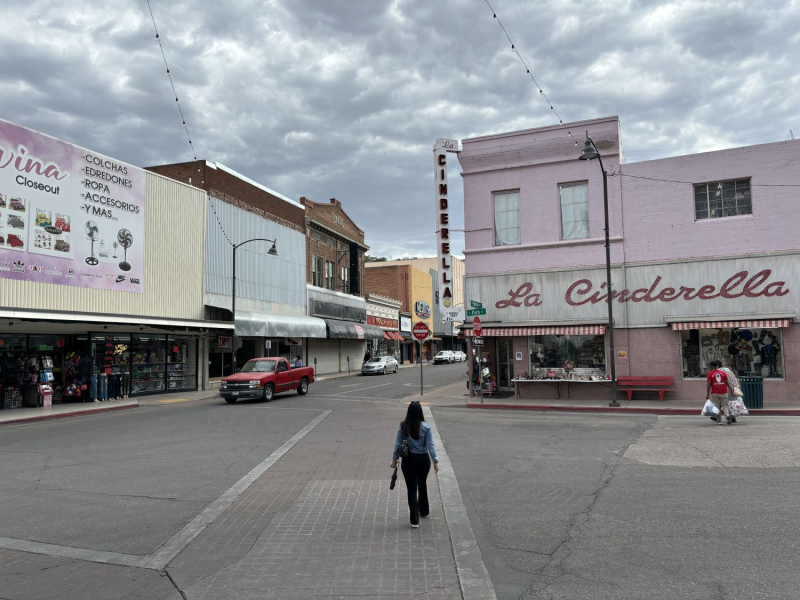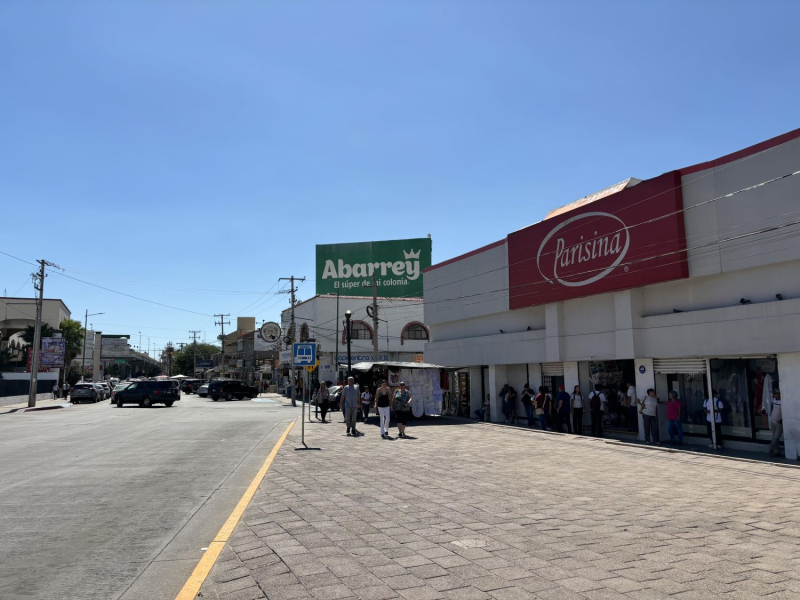
Photo: Max Herman Agence France-Presse From Nogales, Arizona, “Le Devoir” went to Nogales, Mexico.
Stéphane Baillargeon In Nogales, Arizona and Mexico
Published at 0:00
- United States
In two weeks, the presidential elections in the United States will be decided in a handful of swing states, including Nevada and Arizona, where the Republican and Democratic candidates remain neck and neck. This series offers a political journey through these areas of fierce struggle. Today: the story of crossing a world in between, in a city with two countries, at a time when immigration is emerging as one of the decisive issues.
In the hole of a deep valley lives Nogales. In fact, two Nogales coexist and exchange symbiosis in the pass of desert hills on the American-Mexican border.
At the beginning of the month, it was necessary to go between these two worlds on foot since the rental car was not insured to drive in Mexico. And why not ? Arriba!
The McDonald’s in Nogales, on the American side, charges $20 to park a vehicle for the duration of the walk, proof that it is quite common. Across the street, on the sloping Crawford Street, a large building offers storage spaces for rent and a currency exchange office, other signs of this interworld.
At the intersection, turn right onto Grande Avenida, past stores selling very low-end clothing and toys, amplifying the impression of already being a bit in Mexico, especially with Spanish heard everywhere.
The Arizonan villages and hamlets often give the same impression of a “developing” country rather than the richest and most powerful empire in the world. In addition, near Nogales on the American side, road signs display distances in kilometers and not miles, a relic of a switch to the metric system aborted in the rest of the country half a century ago.
La garita and its heavy rotating pedestrian barrier are a few meters away at the end of the sidewalk. A few more steps and here is the strange border control. The guard on duty does not even ask to see the passport. Slumped on a bad chair, he waves his hand to say to move along, leaving the backpack on the scanner belt. A short, narrow corridor leads to kiosks of knick-knacks announcing with kitsch the entrance to the other Nogales…

Photo: Stéphane Baillargeon Le Devoir The Mariposa border crossing
« Pharmacy! »
At the first intersection, a tall, slender guy approaches, leans over a little and says: «Pharmacy». In English. As if he were offering narcotics.
He offers discounted medications. “Much cheaper,” he promises, implying American comparison prices.
What’s the point of this slightly shady middleman?? Pharmacies and dentists are everywhere, in profusion. On the small stretch of Pesqueira Street alone, the one closest to the guardhouse, around the souvenir shops, a dozen of these centers advertise their medical services in English, including orthodontics, which requires frequent visits.
So it is with this land. Candidates for elections at all levels, from presidential hopefuls to the many sheriffs’ posts, talk ad nauseam about the border to be sealed as a dangerous sieve for criminals. The media relays the obsession. The omnipresent corten steel wall on the geopolitical demarcation line recalls the efforts made to control migratory flows. Or to give the impression of doing so.
This Manichean perspective obscures the reality of complex life here below. The guard dogs bark, the caravans of goods, services and people pass by…
In the same series
- The poet, Nogales and the border
- Portrait of the Trumpist activist in training
- Sheriff, for better and for worse
- In Arizona, meeting at the conspiracy cinema for the film “Vindicating Trump”
An economic heart
The place’s name derives from the hazelnut trees that still grow in the area, though the palms imported in the 19th century seem more abundant. The northern portion has belonged to the United States since the acquisition of a vast territory from Mexico in 1853 to allow the young American Republic to build a southern transcontinental railroad, a project that was soon abandoned.
The Arizonan city has had a little over 20,000 inhabitants for decades and a handful of border gates, through which more than 30 billion goods pass each year. This urban bulge lives off commercial exchanges, including transactions with the thousands of Mexicans who pass through daily to shop at the gringos.

Photo: Stéphane Baillargeon Le Devoir Nogales, on the American side
The southern part of Nogales has been expanding steadily for at least thirty years. It is now home to many more than the 200,000 officially counted inhabitants. Many work in the hundred or so maquiladoras in the surrounding area.
The region produces a lot of fruit and vegetables that are exported daily to the north: tomatoes, melons, mangoes, grapes, anything that requires five-peso agricultural labor. The state of Sonora benefits from the large port of Guaymas on the Sea of Cortes, a link in the great global supply chain. The connection between the two Nogales makes it easier for tourists to enter by car… or on foot.
The Kino mission
Teenagers in school uniforms met on Reforma Street laughingly agreed to exchange a few words in English to express their surprise that a journalist would walk all this way under a blazing sun, when taxis cost next to nothing. Near a large cemetery, two men were changing a tire on a very tired Toyota van. Nothing transcendental to be gained from there once the greetings are made in clumsy Spanish, any more than at a convenience store where a bottle of water can be bought in dollars.
The walk lasted a good two hours through the colorful residences and the streets better maintained than in Quebec (it’s not difficult) with the same electrical wires hanging everywhere. The goal was simply to make the loop to the Iniciativa Kino para la Frontera.

Photo: Stéphane Baillargeon Le Devoir Nogales, Mexico side
The charity occupies a beautiful white building nearby, guarded like a fortress. Interview requests from Devoir in previous weeks never elicited the slightest response. The promise of contact made by a spokesman who rushed to the sentry box was also not kept.
The Kino Border Initiative has been a group of six Catholic missions that offer services to migrants since 2008. The organization’s name refers to the Italian Jesuit Eusebio Kino (1645-1711), who explored and mapped the Pimeria Alta region on the current border. He also ran missions there. He founded the one at San Xavier del Bac in 1692. The beautiful site in the suburbs of Phoenix has been on the National Register of Historic Places since 1966.
The Kino Initiative provides daily support to migrants who approach the wall to try to cross it. About twenty of them were waiting for a meal to be served just across the street in a rather dark room near large corn-cake ovens. Families, including quite young children, several of them from Central America, the head chef, a Kino employee, quickly explained.
“We offer this service on Mondays and Wednesdays,” she added. “People come here to rest, to eat, or to participate in a workshop where they prepare food that they will then sell in town.”
“What Brings Us Together”
This strange cafeteria and its wretches are located a few dozen meters from the Mariposa border crossing, which provides access to the United States by vehicle or on foot. The port of entry opened in 1973 and was completely rebuilt a decade ago, in the wake of the reinforcement of the border after the attacks of September 11. The architects of Studio Jones have pushed symbolic irony to the point of piercing the polished concrete walls with holes and leaving footprints in them.
A plaque reproduces verses by the poet Alberto Ríos entitled Border Lines, written on the occasion of a visit to Arizona by Mexican President Vincente Fox in 2003. The text reads: “Let us turn the map until we see clearly: The border is what joins us/Not what separates us. »
In any case, the checks are more serious on the way back. This time, the customs officer checked the passport. Once the border was crossed, a customs officer arriving at her shift specified that the way to McDonald’s and the car would only be by highway.
Ricardo, an Uber driver called to the rescue, normally works on freight trains. He supplements his income by driving a taxi. Born in Mexico, he spent «the line » in his late teens, about forty years ago.
“It was very easy back then. I quickly became an American. But I often return to Mexico.” He might as well have quoted the poet of this middle land: “Let’s turn the map over until we see clearly/The border is what brings us together/Not what separates us”…
This report was funded with support from the Transat International Journalism Fund-Le Devoir.

